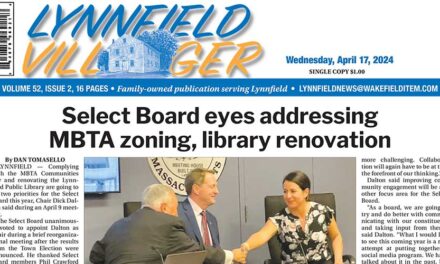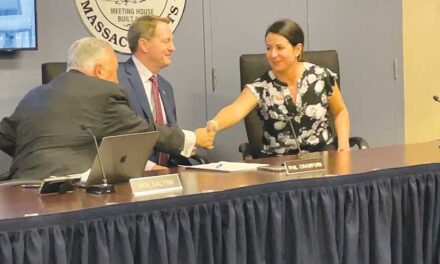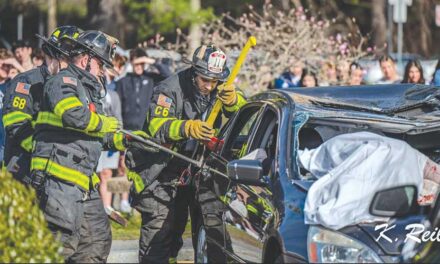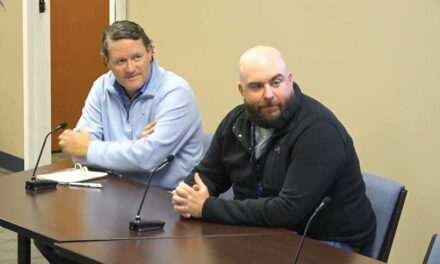Published February 12, 2020
By DAN TOMASELLO
LYNNFIELD — Mental health, distracted driving and substance abuse are among several areas of concern that officials are looking to address in the town’s schools.
Teaching and Learning Director Kevin Cyr told the School Committee on Feb. 4 that students in grades 7-12 took the Youth Risk Behavior Survey (YRBS), which was funded by a $7,500 grant from Lahey Health, last October. He explained that the survey was last administered during the fall of 2017. Students were able to opt out of the confidential survey.
Substance Abuse Prevention Coordinator Peg Sallade said the school system and A Healthy Lynnfield used the data from the 2017 survey to develop programming for students and families as part of an effort to address several areas of concern. She said the results from the 2019 survey will also be used to develop programming.
“This is a school-sponsored survey for the students in the Lynnfield Public Schools, but it’s not only the schools’ responsibility to keep our kids healthy,” said Sallade. “It’s a community responsibility. The main goal of the survey is to assess students’ health risks.”
LMS results
Lynnfield Middle School Principal Tom Sallee said the survey’s results revealed that seventh and eighth graders “are healthy and have low risk health behaviors compared to their peers in the commonwealth and across the nation.”
Sallee said some of the middle school’s “low areas of concern” include adequate sleep, nutrition, physical activity and unintentional injuries.
While Sallee is not concerned about certain student behaviors, he is concerned about the rise in cyberbullying. He said the number of students who reported being bullied electronically increased from 15.1 percent in 2017 to 27.6 percent in 2019. He also noted that the number of middle school students who reported being bullied on school property dropped from 29.1 percent in 2017 to 18.2 percent in 2019.
“My theory is that bullying is moving into spaces where there are no adults,” said Sallee. “That is the next thing we need to work on conquering.”
Middle school adjustment counselor Marisa Botta said the percentage of students “who felt sad or hopeless two or more weeks in a row is 14.5 percent or 44 students.”
“I think that is a pretty low number considering that adolescents have a roller-coaster ride of emotions,” said Botta. “I am not surprised by the number and actually thought it could have been higher. We did see an increase in the number of students getting mental health treatment. In 2017, 18 students reported they were receiving treatment. In 2019, 30 students reported receiving treatment.”
Botta said 42 percent of students reported being stressed by school demands while 26.2 percent reported being stressed due to their busy schedules. Additionally, she said 11.6 percent of students reported being stressed by family expectations/demands and 7.3 percent stated family issues caused emotional stress.
“The numbers are very similar to what we saw in 2017,” said Botta.
Botta said 29 middle school students reported having suicidal thoughts in 2019, which is higher than the 22 students who reported being suicidal in 2017. She said the number of students who reportedly made a plan to commit suicide dropped from 17 students in 2017 to 15 students in 2019. She said five students reported attempting suicide in 2019, which is slightly less than the seven students who reported attempting suicide in 2017.
Sallee noted a number of middle school families have utilized the INTERFACE referral service helpline for additional support outside of school.
In response to a question from School Committeeman Tim Doyle, Sallade said INTERFACE is a “contracted service with William James College that provides a helpline for someone looking for mental health outpatient services.”
“That is available to all residents and families regardless of age,” said Sallade.
Middle school psychologist Cara Olson said the percentage of middle school students who reported using alcohol and drugs is really low.
“We want to keep it that way,” said Olson.
Olson said the percentage of students who reported using prescription drugs without a prescription increased from 1.5 percent in 2017 to 3.4 percent in 2019.
While Olson said 11.7 percent of middle school students reported trying alcohol, she said 0.3 percent of students reported currently drinking alcohol. She said 1 percent of students reported smoking marijuana.
According to the survey, 3.1 percent of middle school students reported having sex in 2019, which is higher than 2017’s average of 1.9 percent.
LHS results
Similar to the middle school, Lynnfield High School Assistant Principal Brian Bates said “students are reporting overall healthy behaviors” compared to other students in the state and the U.S.
Bates said one of the “red flags” revealed from the survey included students not receiving adequate sleep. He said 82.5 percent of students reported not getting eight hours of sleep on school nights.
“That is slightly higher than the Middlesex League, state and national rates,” said Bates.
Bates also expressed concerns about the rise in students who reported driving after smoking marijuana. He said 11.3 percent of students reported smoking pot while driving in 2019, which is higher than the 8 percent who reported getting behind the wheel stoned in 2017.
“That is eye-opening to us,” said Bates. “That is something we need to educate high school students about.”
Bates is also concerned about the number of students who reported using cell phones and texting while driving. He said the number of students who reportedly made phone calls while driving increased from 41.7 percent in 2017 to 43.9 percent in 2019. He said the number of students who said they sent text messages while driving spiked from 31.3 percent in 2017 to 44.9 percent in 2019.
In order to raise awareness about the dangers of smoking marijuana and driving as well as distracted driving, Bates said the high school’s mock car crash this spring will be incorporating both elements.
“That is one immediate step we are taking to address it,” said Bates.
Bates said 19 students reported being the victims of sexual dating violence in 2019, which is less than the 26 students who reported it in 2017.
“It has significantly decreased since 2017,” said Bates. “We continue to educate our students about it.”
LHS nurse Mary Homan said the high school brought Deana’s Educational Theater’s production of “The Yellow Dress” to the high school last year. She said the one-act play is about a high school girl who gets murdered by her boyfriend.
“It’s about healthy relationships,” said Homan. “It’s very powerful.”
While the middle school has experienced an increase in cyberbullying, Bates said electronic bullying decreased from 8.3 percent in 2017 to 7.8 percent in 2019. He said the survey’s results revealed that bullying on school property increased from 7.4 percent in 2017 to 11.6 percent in 2019.
“I just don’t see that,” said Bates. “At the high school, typically two things happen. One is a student or a parent will come to us and will say that a student is being bullied when in actuality it’s a confrontation two students are having. Number two, typically when we do have a bullying incident, it stems directly from social media. It’s something we need look into.”
High school adjustment counselor Kristen Dee said the percentage of students who reported feeling sad and depressed increased from 100 students in 2017 to 126 students in 2019. She said the number of students who reported hurting themselves on purpose increased from 42 students in 2017 to 58 students in 2019.
“Kids are experiencing anxiety and depression at higher rates,” said Dee.
Dee said the number of students who reported being suicidal increased from 47 students in 2017 to 58 students in 2019. She said the number of students who reported attempting suicide increased from 13 students in 2017 to 16 students in 2019.
“We are below the Middlesex League, state and national averages,” said Dee.
Dee said the high school has implemented the Signs of Suicide (SOS) prevention program, which she said LHS officials and teachers have found to be “very helpful.” She said 18.1 percent of students reported receiving mental health treatment in 2019, which is higher than the 11.3 percent who reported receiving treatment in 2017.
According to Dee, 31.8 percent of students reported being stressed due to school demands. She said 30.2 percent of students stated they were stressed due to their busy schedules.
Bates expressed doubts about the accuracy of the number of students who reported vaping. According to the survey, the number of students who smoked e-cigarettes dropped from 22.3 percent in 2017 to 15.3 percent in 2019.
“These numbers don’t correlate to what I see,” said Bates. “I see numbers that are much higher than the 15.3 percent.”
Bates also said 19.2 percent of LHS students reported drinking alcohol in 2019, which is higher than the 2017 average of 16.6 percent. He said the number of students who reported smoking marijuana increased from 11.6 percent in 2017 to 14.9 percent in 2019.
“Students don’t perceive marijuana to be as dangerous as vaping, alcohol and other drugs,” said Bates. “One out of every two students believes marijuana is harmful. I think that is in part because it’s legal. We need to have more education about the harmful effects of marijuana.”
Bates said 24.2 percent of high school students reported having sex in 2019, which is higher than 2017’s average of 19.3 percent.
SC reaction
School Committee Vice Chairman Rich Sjoberg thanked the group of educators for giving a thorough presentation. He raised the possibility of having a follow-up discussion about the survey’s results at a future meeting.




